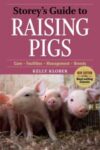
Breed Facts
Status:
Critical
Use:
Lard/Back Fat, Meat
Adult Weight:
Male & Female – 400-600 lbs.
Temperament:
Docile, Active
Experience Level:
Beginner
Notes:
May be used for Charcuterie, Sausage/Ground, Roasts, Ham
MULEFOOT
The Mulefoot is an American hog breed named for its most distinctive feature: the solid, non-cloven hooves similar to a mule’s hooves (syndactylism). This characteristic occasionally occurs as a single gene mutation, producing “mulefooted” pigs within a variety of other breeds. In contrast, the Mulefoot hog is consistent in appearance and behavior, with qualities that have made it valuable in American history and a conservation priority.
The origin of the Mulefoot is unclear and multiple theories have arisen about its links with mulefooted stocks in Eurasia. The breed is more likely to have descended from the Spanish hogs brought to the Americas beginning in the 1500s. It shares some attributes with the Choctaw hog and the two breeds likely came from the same ancestral stock, which was loosely selected and managed until the late 1800s.
By 1900, the Mulefoot became a standardized breed. It was valued for ease of fattening and production of meat, lard, and especially hams. Mulefoot hogs were distributed throughout the “Corn Belt” but were also common along the Mississippi River Valley. According to Jeannette Beranger of The Livestock Conservancy, “A lot of the time, American Mulefoot hogs were managed on river islands.They’d forage all summer long, then when it came to butchering time in the fall, people would just go out to the islands and take what they needed.” In the early 1900s, there were two Mulefoot breed associations and over 200 herds registering purebred stock.
In 2014, The American Mulefoot Breeders Association (AMBA) was founded to promote and preserve the breed.
Mulefoot hogs are compact in appearance and weigh 400-600 lbs. They are solid black with white points occurring rarely. The AMBA accepts pink or white dots/marks on the snout and white “anklets” right above the hoof wall. However, white hooves and bellies are not acceptable. Neither are red, white, striped or other coat colors. Kinked, stumped or clipped tails are also not acceptable. The ears are pricked forward. Some pigs have wattles on either side of the neck, although this is not common. The breed forages well and thrives under extensive husbandry. They have litters of 5-6 piglets but may have as many as 12. The sows are excellent and calm mothers. Their meat is said to “melt in your mouth,” is very tender, and is appreciated by gourmet chefs. It is a hardy breed, has a gentle disposition, and is a good forager. They can thrive in nearly any climate with proper shelter.
Most of the existing herds of Mulefoot hogs were started using animals from the Holliday herd of Missouri; the breed is critically rare and this friendly, docile, and intelligent hog is in need of new stewards if they are to survive.
Did you know:
The Livestock Conservancy is America’s leading organization working to save over 190 heritage breeds from extinction. We rely on the support of our members, grants, and donations from the public to raise the $1 million needed each year to maintain our conservation work with rare breeds of farm animals. Click here to learn how you can help.

Storey’s Guide to Raising Pigs
– Kelly Klober
$19.95
An Introduction to Heritage Breeds
– D. Phillip Sponenberg, Jeannette Beranger. Alison Martin
$19.95


